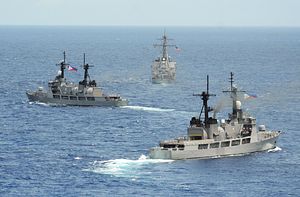This week, the Philippines’ new naval chief grabbed headlines when he said that the country should pursue submarines as part of its military modernization not only to add to its limited capabilities, but also to gain the respect of other regional actors. Though the comments were the subject of much local media coverage, they in fact represent just the latest restatement of the Philippine pursuit of the capability in spite of the significant challenges it faces in doing so.
The idea of the Philippines developing a submarine capability is not a new one and dates back to at least the 1990s. Since then, the Philippine government has studied the issue and taken some initial steps towards that long-term goal, including setting up a submarine office in 2013. And over the past few years, as more regional states had moved to either acquire submarines or expand or upgrade existing capabilities – not just China but also neighboring Southeast Asian countries like Vietnam, Singapore, Indonesia, Malaysia, Thailand – the idea has gained even more steam (See: “A New Plan to Manage Asia’s Submarine Race”).
To be sure, in reality, with the Philippines still one of the region’s weakest militaries and significant investments required in more basic capabilities as well to counter a series of internal and external challenges, a submarine capability would be an expensive investment – in terms of not just the equipment itself, but also the supporting people, technology, and facilities (See: “The Truth About Philippine Military Modernization and the China Threat”). But as part of a longer-term military modernization effort, a submarine capability would also admittedly be useful for helping address aspects of some of these challenges, including preserving the Philippine position in the South China Sea, or what is left of it (See: “Will a China-ASEAN South China Sea Code of Conduct Really Matter?”).
Within the current context of the ongoing Philippine military modernization program, which is divided into three horizons and phases out to 2028, a submarine capability has been expected to occur either in the Second Horizon (2018-2022) or the Third Horizon (2023 to 2028). Philippine defense officials have indicated that this is still the case under Duterte, even though few additional specifics have been provided, including the potential number of submarines as well as where they would be sourced from, whether new or old (See: “What’s Next for Philippine Military Modernization Under Duterte?”).
So it was little surprise when we saw yet another reiteration of the general call to realize the Philippines’ submarine dream. In response to a question posed at a hearing at the Philippine Senate, the Philippine Navy’s (PN’s) chief Rear Admiral Robert Empedrad, who was just approved in December for his position, said that submarine warfare was “the future of naval warfare” and that the acquisition of submarines would be useful in the context of the country’s military modernization both in terms of the capabilities it would add as well as the respect that the PN would gain from other navies.
Empedrad’s comments about submarines merely reconfirm that despite the fact that submarines are an expensive capability for cash-strapped countries to develop and then sustain, they continue to be regarded as an integral weapon in a nation’s arsenal and also a symbol of prestige rooted in a ‘keeping up with the Joneses’ mentality we have seen in other Asian states as well.
But as Empedrad implied in his remarks, there are still “a lot of concerns” remaining about the Philippines’ naval modernization. Indeed, Empedrad’s own recent appointment was a product of some of those issues, with his predecessor Vice Admiral Ronald Joseph Mercado removed in December for issues related to a frigate program which is the subject of an ongoing inquiry and domestic scrutiny (See: “Frigate Controversy Puts Philippines’ Military Challenges in the Spotlight”). Those “concerns” mean it is still far from clear when, if ever, the Philippines’ submarine dream will become a reality.
































